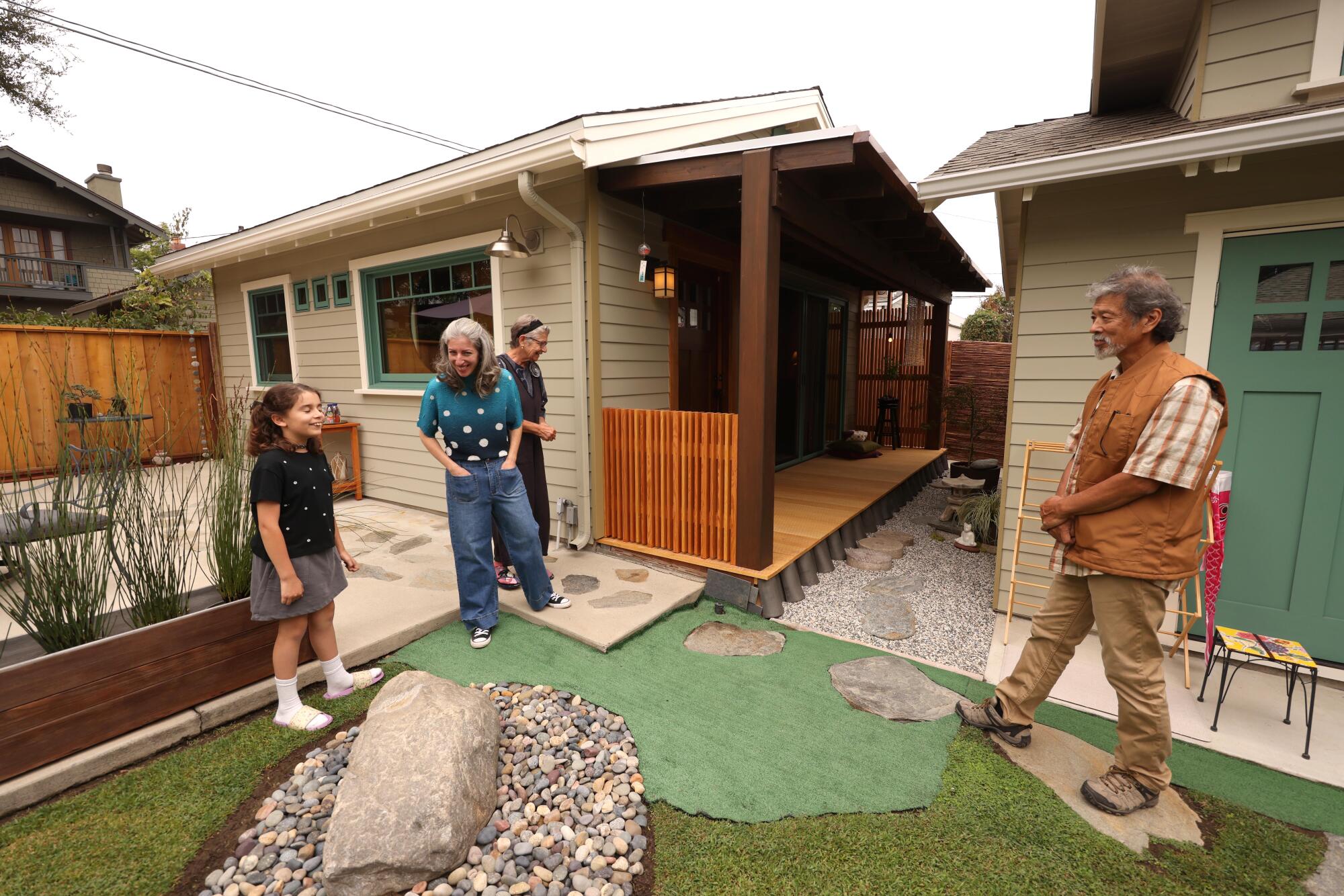
- Share via
- Unable to find an affordable home in Los Angeles, Alexis Altounian and her husband and daughter moved into her 100-year-old childhood home in South Pasadena.
- Her 72-year-old mother, Lizabeth, then moved into a Japanese-style ADU behind the home.
- Craftsman on the outside, Japanese on the inside, the ADU provides serenity along with housing for Lizabeth.
Lizabeth Altounian’s South Pasadena accessory dwelling unit is more than just a living space. It’s a manifestation of beauty, wonder and spirituality, all intertwined. This 400-square-foot former garage, adorned with traditional Japanese shoji screens, a platform bed with a tatami mat and a covered engawa porch running along the entrance of the house, reflects her childhood in Monterey Park, where she dreamed of living in a traditional Japanese home as many of her friends did.
“I fell in love with our neighbor’s home,” recalls Altounian, 72, of one particular friend. “Every time I stepped inside, I was in awe of their tatami room and furniture. It was so unique to me, especially since my family is Armenian.”
Altounian and her Japanese friends at school were close despite their cultural differences. “At lunch, we would trade food. I would eat their rice balls, and they would eat whatever Armenian food my grandmother put in my lunch box that day. That stayed with me all my life.”


Altounian’s 100-year-old home in South Pasadena is a traditional Craftsman. However, when she toured the bungalow for the first time in 1984, she had an emotional response equal to what she’d felt for her childhood friend’s home.
“When I walked in, I started crying,” she says of the open house. “I saw the built-ins and thought, ‘This is my home.’”
For the record:
6:56 a.m. Jan. 3, 2025An earlier version of this story incorrectly spelled the first name of Lizabeth Altounian as Elizabeth.
She and her husband, Warren, raised two children in their home and added a second floor to the bungalow in the early 1990s. When Warren died in 2011, her life changed in many ways. “My kids started doing their own thing,” she says. Lizabeth was often alone. “Taking care of a house can be overwhelming,” she adds.


To help alleviate their grief after Warren’s death, Lizabeth and her daughter, Alexis, escaped by watching the Japanese gardening show “At Home With Venetia in Kyoto,” hosted by British herbalist Venetia Stanley-Smith on NHK World Japan.
“It became a part of us,” Alexis says. “It was a beautiful escape and a way to think about life and the things that we love. Also, we knew that Dad would love that show.” Several years later, the family visited Kyoto and Tokyo, including the Ohara District, where the television series was filmed.
“That’s how this all started,” says Alexis of the show. She now lives in her childhood home with her husband, Mike Ontiveros, and their daughter, Audrey, 8. “We wanted my mom to stay in her home and have a multigenerational household, but I wanted it to be special.”



Kawabata created custom walnut cabinets in the kitchen with wood inlay, a lazy Susan and space-saving pull-out storage.
The couple’s housing trajectory is familiar in Los Angeles, where the average home price is $952,114, according to Zillow, and inventory is low. After renting a townhouse in South Pasadena and Alhambra, the couple decided to look for a home during the COVID-19 pandemic, when interest rates dropped to record lows.
“We looked in Pasadena, South Pasadena and Monrovia, and the home prices were sky-high,” says Alexis. “It was intense. There would be 20 people ahead of us in masks touring the houses, prepared to make all-cash offers.”
When the couple decided to purchase a home nearly 40 miles away in Valencia, Ontiveros reassured his mother-in-law that she would see her granddaughter regularly as they would only be “40 minutes away on the freeway.”
It was a decision that weighed heavily on Lizabeth’s heart.


“It was the everyday things that I wanted to share with her,” Lizabeth says. “I wanted to pick her up from school and take her to In-N-Out Burger; small things. Having that time with my granddaughter is precious.”
For a long time, Lizabeth and Alexis researched California’s ADU laws, which have been implemented to address the state’s housing crisis and lack of affordable housing. They even appeared at their neighborhood council meeting in an emotional plea for less restrictive ADU laws in their longtime neighborhood.
So when the city of South Pasadena complied with state law in 2019, allowing homeowners to build an ADU on their property, Lizabeth decided to turn her two-car garage into an ADU. “I told them, ‘You can live here, and Audrey can attend a great school. It’s a win-win, especially for me, because I will still have my neighbors and the life I had.’”


Overwhelmed by their inability to purchase a home in South Pasadena, where Alexis’ family is a longtime part of the community, the couple accepted.
“I wanted my daughter to have the same elementary school experience that I did,” says Alexis. “The school is within walking distance of the house. I am happy living here, but I am most happy that my daughter can spend time with her grandma.”
Although the city of South Pasadena required the exterior of the ADU to match the Craftsman style of the main house, the family asked architect Julie Ann Abajian to convert their garage into a Japanese-inspired ADU and add a 200-square-foot junior ADU just a few feet away, which Lizabeth could use as a work shed.
“One is a living space, and one is a doing space,” Lizabeth says, laughing.


After meeting with Japanese American carpenter and woodworker Toshi Kawabata of Barrban Woodworks and touring some of his projects, the family knew they had found someone who could help them design a home that reflected Lizabeth’s love of Japanese culture and suited her desire to live with less.
“When we met him, we explained how much we loved the obscure NHK show and our trip to Japan, and he told us his wife knew Venetia,” says Alexis, referencing the TV host. “That’s when we knew it was meant to be.”
While Abajian handled the conceptual interior design and finishes, the Altounians gave Kawabata “the freedom to do whatever he felt was the right thing to do,” Lizabeth says. “He is the master. I’m not going to tell him what to do.”
The ADU, which cost about $375,000, is uncluttered, with open beams exposing redwood planks and walls lined with juraku plaster, a traditional Japanese wall finish made of clay, sand, straw and water. Yohta Idekawa installed the plaster, which helps keep the ADU cool and adds texture to the different wood species, including cherry, walnut and cedar.
“My closet smells so good,” Lizabeth says with delight.



The Japanese-style bathroom features a stone sink, smooth pebbles in the walk-in shower and a Japanese brand Toto toilet that automatically opens and closes when someone passes in front of it.
The space feels serene thanks to a surplus of built-in storage masterminded by Kawabata, including pull-out drawers under the raised tatami platform, closets backed with sliding shoji screens and tall pull-out cabinets in the kitchen. Beneath a Noguchi paper pendant, a sofa rests next to a built-in raised tatami bed with a futon and comforter from the home furnishings store Takaokaya in Kyoto. An electric fireplace rests on top of pebble flooring. There is no television.
To help connect the ADU to the garden, Abajian designed a dramatic circle window that brings the outdoors in. “When you are sitting inside the ADU, you can see the greenery of the trees,” Alexis says. It’s the same view, from a different angle, that her mother had while living in the main house. “There is a continuity of what she’s been seeing for 40 years in the same house — our neighbors, that view and their palm trees.”

Because she is not a big cook, Lizabeth wanted a simple kitchen with a convection microwave and an electric cooktop. There is no dishwasher or garbage disposal and no dining room for the moment. “I ordered a bistro table and chairs, but it didn’t feel right,” she says. For now, she prefers to eat outside in her garden.
Many walnut cabinets, augmented by a handmade tile backsplash from Mission Tile West in South Pasadena, feature a decorative inlay floral pattern, a common motif in Japanese woodworking.
The junior ADU serves as Lizabeth’s workshop, because she wanted her living area to be simple. There, she stores her tools and garden equipment. There’s a utility sink, laundry, a workbench, a shared refrigerator and storage. “It makes the 400 square feet feel less restrictive,” she says. Her only regret? “We should have installed an HVAC system.”


On a typical day, when relaxing, Lizabeth can sit at her chabudai (a low Japanese tea table), look out her circle window and enjoy the seasons. She says her home has been teaching her lessons, such as a new appreciation for “the serenity and quiet of the space.”
Every day, she says she is grateful to “Mr. Kawabata” for making her dream of living in a traditional Japanese home come true.
“We wanted her to have peace and tranquility and something that gives her joy,” Alexis says of their multifamily compound. “It brought us all together after losing my dad. It has brought us a lot of comfort.”


More Los Angeles ADUs
She couldn’t afford a bigger house in L.A. So she built a stylish ADU for $230,000
After a decade of working out of coffee shops, two L.A. filmmakers add an ADU — twice
In L.A.’s tough housing market, cramped family adds ADU rather than move
First, they built an ADU ideal for surfers. Now, they’re ready to travel like nomads
They added an ADU that’s ‘not too big’ and ‘not too small’ to their L.A. fixer-upper
They spent $354,000 to build a modern ADU. Now they rent it out for $4,500 a month
How L.A. architects designed a 300-square-foot ADU that pulls in $1,750 a month
How a Spanish bungalow in L.A. went from sad to sexy (Hint: There’s an ADU rental)
She wanted more than a guesthouse for her sister. This tiny ADU in L.A. delivers
This ADU rental with windows galore is a houseplant lover’s dream
More to Read
Sign up for This Evening's Big Stories
Catch up on the day with the 7 biggest L.A. Times stories in your inbox every weekday evening.
You may occasionally receive promotional content from the Los Angeles Times.












